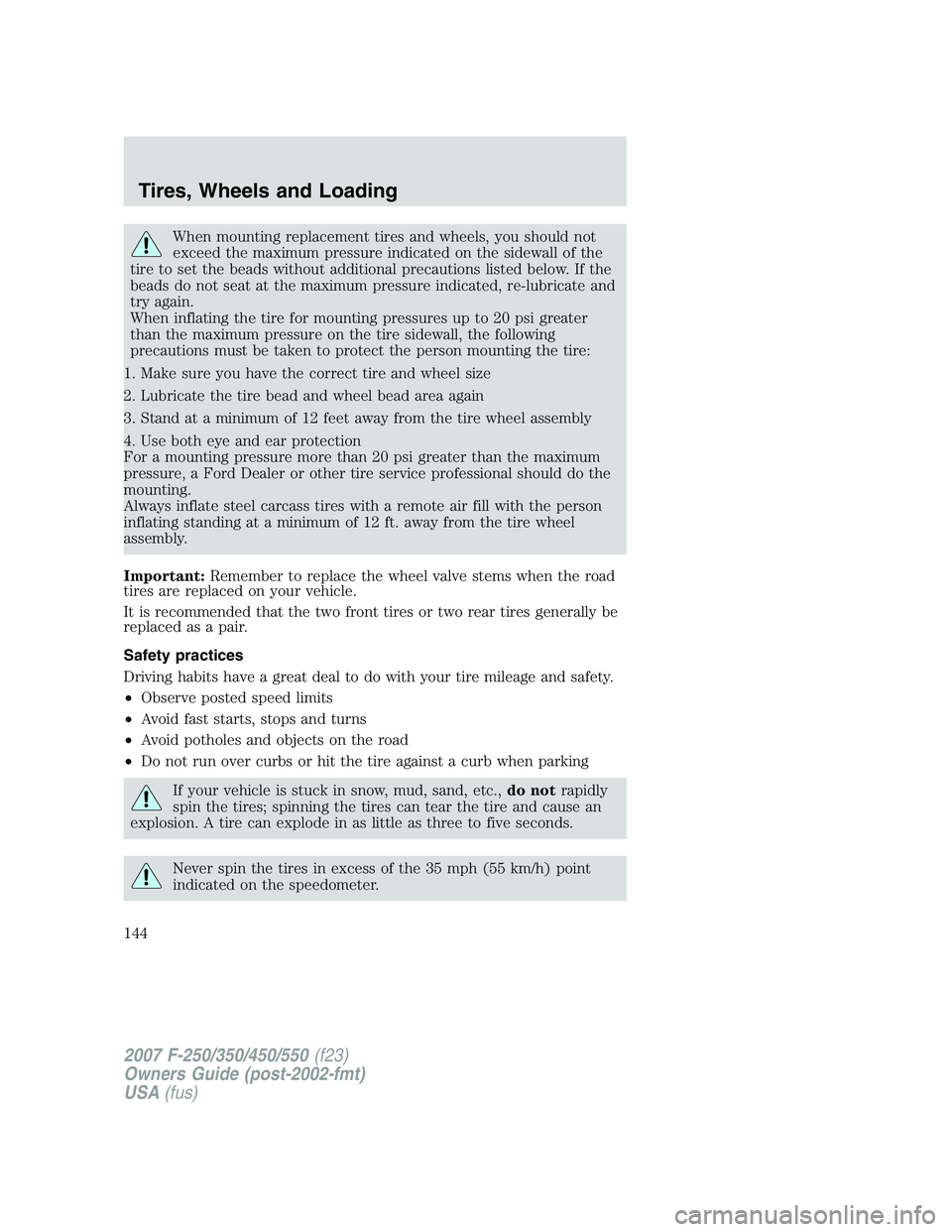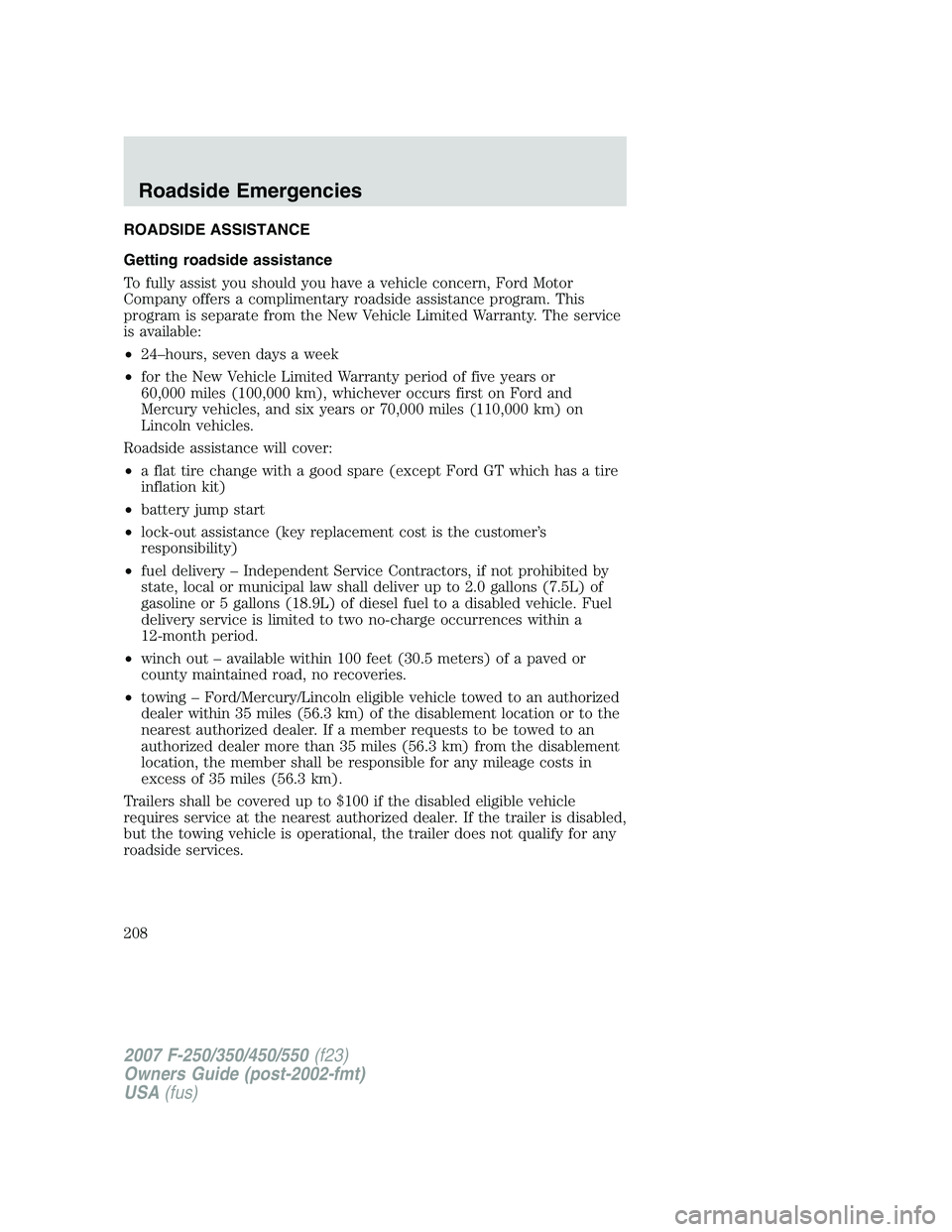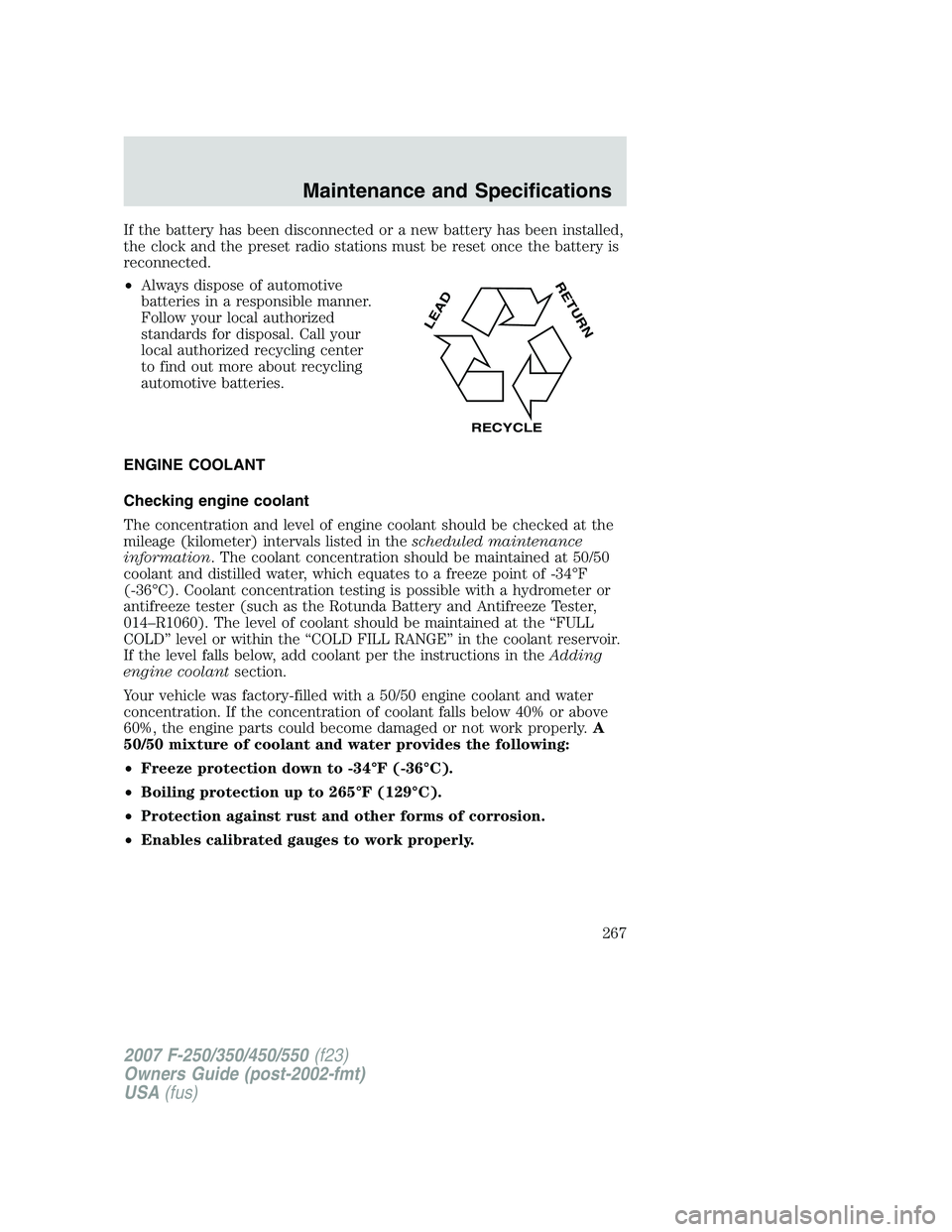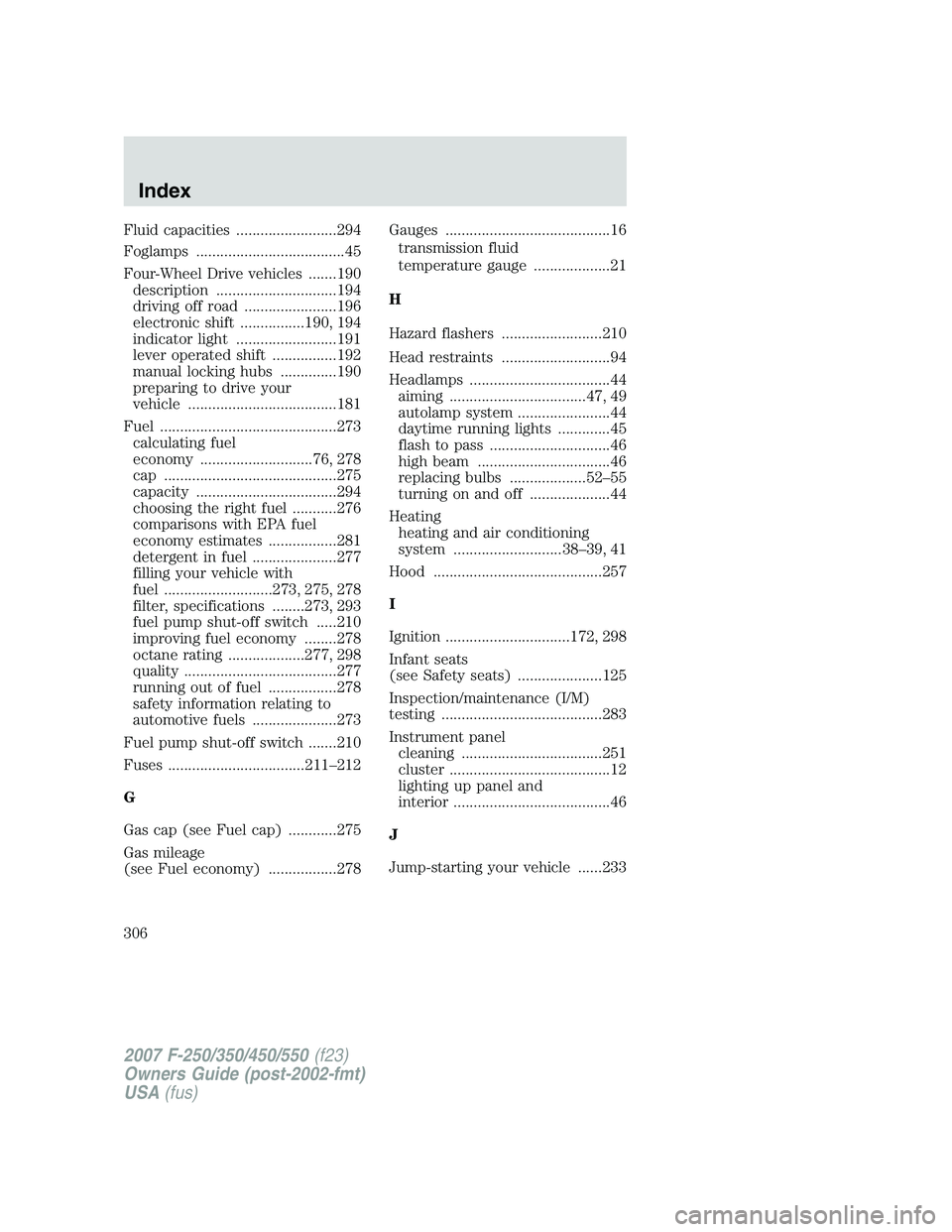2007 FORD F250 mileage
[x] Cancel search: mileagePage 144 of 312

When mounting replacement tires and wheels, you should not
exceed the maximum pressure indicated on the sidewall of the
tire to set the beads without additional precautions listed below. If the
beads do not seat at the maximum pressure indicated, re-lubricate and
try again.
When inflating the tire for mounting pressures up to 20 psi greater
than the maximum pressure on the tire sidewall, the following
precautions must be taken to protect the person mounting the tire:
1. Make sure you have the correct tire and wheel size
2. Lubricate the tire bead and wheel bead area again
3. Stand at a minimum of 12 feet away from the tire wheel assembly
4. Use both eye and ear protection
For a mounting pressure more than 20 psi greater than the maximum
pressure, a Ford Dealer or other tire service professional should do the
mounting.
Always inflate steel carcass tires with a remote air fill with the person
inflating standing at a minimum of 12 ft. away from the tire wheel
assembly.
Important:Remember to replace the wheel valve stems when the road
tires are replaced on your vehicle.
It is recommended that the two front tires or two rear tires generally be
replaced as a pair.
Safety practices
Driving habits have a great deal to do with your tire mileage and safety.
•Observe posted speed limits
•Avoid fast starts, stops and turns
•Avoid potholes and objects on the road
•Do not run over curbs or hit the tire against a curb when parking
If your vehicle is stuck in snow, mud, sand, etc.,do notrapidly
spin the tires; spinning the tires can tear the tire and cause an
explosion. A tire can explode in as little as three to five seconds.
Never spin the tires in excess of the 35 mph (55 km/h) point
indicated on the speedometer.
2007 F-250/350/450/550(f23)
Owners Guide (post-2002-fmt)
USA(fus)
Tires, Wheels and Loading
144
Page 208 of 312

ROADSIDE ASSISTANCE
Getting roadside assistance
To fully assist you should you have a vehicle concern, Ford Motor
Company offers a complimentary roadside assistance program. This
program is separate from the New Vehicle Limited Warranty. The service
is available:
•24–hours, seven days a week
•for the New Vehicle Limited Warranty period of five years or
60,000 miles (100,000 km), whichever occurs first on Ford and
Mercury vehicles, and six years or 70,000 miles (110,000 km) on
Lincoln vehicles.
Roadside assistance will cover:
•a flat tire change with a good spare (except Ford GT which has a tire
inflation kit)
•battery jump start
•lock-out assistance (key replacement cost is the customer’s
responsibility)
•fuel delivery – Independent Service Contractors, if not prohibited by
state, local or municipal law shall deliver up to 2.0 gallons (7.5L) of
gasoline or 5 gallons (18.9L) of diesel fuel to a disabled vehicle. Fuel
delivery service is limited to two no-charge occurrences within a
12-month period.
•winch out – available within 100 feet (30.5 meters) of a paved or
county maintained road, no recoveries.
•towing – Ford/Mercury/Lincoln eligible vehicle towed to an authorized
dealer within 35 miles (56.3 km) of the disablement location or to the
nearest authorized dealer. If a member requests to be towed to an
authorized dealer more than 35 miles (56.3 km) from the disablement
location, the member shall be responsible for any mileage costs in
excess of 35 miles (56.3 km).
Trailers shall be covered up to $100 if the disabled eligible vehicle
requires service at the nearest authorized dealer. If the trailer is disabled,
but the towing vehicle is operational, the trailer does not qualify for any
roadside services.
2007 F-250/350/450/550(f23)
Owners Guide (post-2002-fmt)
USA(fus)
Roadside Emergencies
208
Page 267 of 312

If the battery has been disconnected or a new battery has been installed,
the clock and the preset radio stations must be reset once the battery is
reconnected.
•Always dispose of automotive
batteries in a responsible manner.
Follow your local authorized
standards for disposal. Call your
local authorized recycling center
to find out more about recycling
automotive batteries.
ENGINE COOLANT
Checking engine coolant
The concentration and level of engine coolant should be checked at the
mileage (kilometer) intervals listed in thescheduled maintenance
information. The coolant concentration should be maintained at 50/50
coolant and distilled water, which equates to a freeze point of -34°F
(-36°C). Coolant concentration testing is possible with a hydrometer or
antifreeze tester (such as the Rotunda Battery and Antifreeze Tester,
014–R1060). The level of coolant should be maintained at the “FULL
COLD” level or within the “COLD FILL RANGE” in the coolant reservoir.
If the level falls below, add coolant per the instructions in theAdding
engine coolantsection.
Your vehicle was factory-filled with a 50/50 engine coolant and water
concentration. If the concentration of coolant falls below 40% or above
60%, the engine parts could become damaged or not work properly.A
50/50 mixture of coolant and water provides the following:
•Freeze protection down to -34°F (-36°C).
•Boiling protection up to 265°F (129°C).
•Protection against rust and other forms of corrosion.
•Enables calibrated gauges to work properly.
L
E
A
D
RETURN
RECYCLE
2007 F-250/350/450/550(f23)
Owners Guide (post-2002-fmt)
USA(fus)
Maintenance and Specifications
267
Page 306 of 312

Fluid capacities .........................294
Foglamps .....................................45
Four-Wheel Drive vehicles .......190
description ..............................194
driving off road .......................196
electronic shift ................190, 194
indicator light .........................191
lever operated shift ................192
manual locking hubs ..............190
preparing to drive your
vehicle .....................................181
Fuel ............................................273
calculating fuel
economy ............................76, 278
cap ...........................................275
capacity ...................................294
choosing the right fuel ...........276
comparisons with EPA fuel
economy estimates .................281
detergent in fuel .....................277
filling your vehicle with
fuel ...........................273, 275, 278
filter, specifications ........273, 293
fuel pump shut-off switch .....210
improving fuel economy ........278
octane rating ...................277, 298
quality ......................................277
running out of fuel .................278
safety information relating to
automotive fuels .....................273
Fuel pump shut-off switch .......210
Fuses ..................................211–212
G
Gas cap (see Fuel cap) ............275
Gas mileage
(see Fuel economy) .................278Gauges .........................................16
transmission fluid
temperature gauge ...................21
H
Hazard flashers .........................210
Head restraints ...........................94
Headlamps ...................................44
aiming ..................................47, 49
autolamp system .......................44
daytime running lights .............45
flash to pass ..............................46
high beam .................................46
replacing bulbs ...................52–55
turning on and off ....................44
Heating
heating and air conditioning
system ...........................38–39, 41
Hood ..........................................257
I
Ignition ...............................172, 298
Infant seats
(see Safety seats) .....................125
Inspection/maintenance (I/M)
testing ........................................283
Instrument panel
cleaning ...................................251
cluster ........................................12
lighting up panel and
interior .......................................46
J
Jump-starting your vehicle ......233
2007 F-250/350/450/550(f23)
Owners Guide (post-2002-fmt)
USA(fus)
Index
306